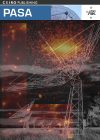In this work, the solution of the standard V light curve of EP And, an over contact binary system, was obtained using the phoebe program. The structure and evolutionary status of the system is discussed. Times of minima data (‘O–C curve’) were analyzed. It was found that a third body with a period of 41.20 yr and mass 0.15 Msun is orbiting around the system. Also, a modulating period of an 11.72-yr cycle along with a relative period increase of  were obtained, which were attributed to the magnetic activity cycle and the mass transfer with rate
were obtained, which were attributed to the magnetic activity cycle and the mass transfer with rate  between the components, respectively.
between the components, respectively.

Publications of the Astronomical Society of Australia
Volume 29 Number 1 2012
AS11037 On the Estimation of Atmospheric Aerosol Extinction Parameters from Measurements in the Johnson–Cousins Photometric System
A procedure to estimate the aerosol extinction parameters of Angstrom’s formula using data taken with broadband filters is presented. The method is based on the determination of the equivalent mean wavelength monochromatic magnitudes from the heterochromatic ones using an iterative approach, correcting subsequently the water-vapour extinction in the longer-wavelength filters.
AS11053 Stark Width Regularities within Neutral Calcium Spectral Series
Electron and proton impact Stark width dependences on the upper level ionization potential within neutral calcium spectral series were studied. The emphasis is on the term structure and temperature influence on these dependences. Using these dependences, predictions were made for lines not being measured experimentally or calculated theoretically until now.
AS11048 Medium-Resolution s-process Element Survey of 47 Tuc Giant Stars
From medium-resolution spectra we derive the C and N sensitive index, δC, for 97 giants and infer abundances of Fe, Na, Si, Ca, Zr and Ba for 13 stars. δC is correlated with Na and could imply that a second era of star formation has revealed the products of CNO-cycle burning.
AS11050 Science at Very High Angular Resolution with the Square Kilometre Array
We discuss the broad range of new and important high-angular-resolution science that will be enabled by the Square Kilometre Array. We highlight the fact that high angular resolution, requiring baselines greater than 1000 km, provides a rich science case with projects from many areas of astrophysics, including important contributions to key SKA science.
AS11050 Abstract | AS11050 Full Text | AS11050PDF (477 KB) Open Access Article
AS11039 The Nature of the Light Variation of the Unique Binary DK CVn
We observed DK CVn and analysed the BVR light curves with phoebe v0.31a software. Several flares were detected and modelled by the OPEA. The model parameters demonstrated that the flares are the same as those of UV Ceti stars. This study reveals that DK CVn should be a chromospherically active binary star.
AS11047 A New Method of Wavelength Calibration for LAMOST by Combining Short- and Long-Exposure Spectral Lines
A new wavelength calibration method which combines short-exposure and long-exposure spectral lines for LAMOST is presented in this paper. Compared with traditional calibration methods which only use short exposures and strong lines, the results of experiments show that the proposed method leads to a calibration of higher precision.
AS11046 RR Lyrae Stars in the Globular Cluster NGC 6101
We present results of a study of RR Lyraes in NGC 6101, undertaken by high school students using the Faulkes Telescopes. We identify one new variable and update parameters of two of the RR Lyraes, as well as providing a new independent estimate of the reddening and distance to this cluster.
AS11071 A Sky-Subtraction Algorithm for LAMOST Using Two-Dimensional Sky-Background Modeling
A novel sky-subtraction algorithm is proposed for the Large Sky Area Multi-Object Fiber Spectroscopic Telescope (LAMOST) based on two-dimensional sky-background modeling. Sky-subtraction can now be performed as an earlier step, before the spectrum extraction. Experiments based on LAMOST are presented to demonstrate the effectiveness of the proposed method.

